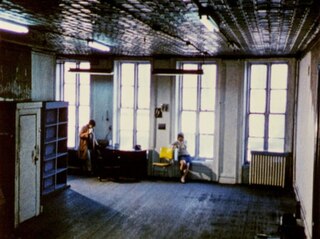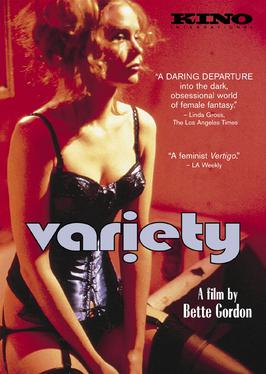Related Research Articles

Film stock is an analog medium that is used for recording motion pictures or animation. It is recorded on by a movie camera, developed, edited, and projected onto a screen using a movie projector. It is a strip or sheet of transparent plastic film base coated on one side with a gelatin emulsion containing microscopically small light-sensitive silver halide crystals. The sizes and other characteristics of the crystals determine the sensitivity, contrast and resolution of the film. The emulsion will gradually darken if left exposed to light, but the process is too slow and incomplete to be of any practical use. Instead, a very short exposure to the image formed by a camera lens is used to produce only a very slight chemical change, proportional to the amount of light absorbed by each crystal. This creates an invisible latent image in the emulsion, which can be chemically developed into a visible photograph. In addition to visible light, all films are sensitive to X-rays and high-energy particles. Most are at least slightly sensitive to invisible ultraviolet (UV) light. Some special-purpose films are sensitive into the infrared (IR) region of the spectrum.

Wavelength is a 1967 experimental film by Canadian artist Michael Snow. Considered a landmark of avant-garde cinema, it was filmed over one week in December 1966 and edited in 1967, and is an example of what film theorist P. Adams Sitney describes as "structural film", calling Snow "the dean of structural filmmakers."
David Edward Gatten is an American experimental filmmaker and moving image artist. Since 1996 Gatten's films have explored the intersection of the printed word and moving image, cataloging the variety of ways in which texts functions in cinema as both language and image, often blurring the boundary between these categories. His 16mm films often employee cameraless techniques, combined with close-up cinematography and optical printing processes. In addition to the ongoing 16mm films, Gatten is now making hybrid 16mm/digital works and has completed an entirely digital feature-length project called The Extravagant Shadows.

In cinematography, bipacking, or a bipack, is the process of loading two reels of film into a camera, so that they both pass through the camera gate together. It was used both for in-camera effects and as an early subtractive colour process.

Color motion picture film refers both to unexposed color photographic film in a format suitable for use in a motion picture camera, and to finished motion picture film, ready for use in a projector, which bears images in color.
The merits of digital versus film photography were considered by photographers and filmmakers in the early 21st century after consumer digital cameras became widely available. Digital photography and digital cinematography have both advantages and disadvantages relative to still film and motion picture film photography. In the 21st century, photography came to be predominantly digital, but traditional photochemical methods continue to serve many users and applications.

The Intruder is a 2004 French drama film directed by Claire Denis. The film had its world premiere in the Competition section at the 61st Venice International Film Festival on 9 September 2004. It was released in France on 4 May 2005.

Nathaniel Dorsky is an American experimental filmmaker and film editor. His film career began during the New American Cinema movement of the 1960s, when he met his partner Jerome Hiler. He won an Emmy Award in 1967 for his work on the film Gaugin in Tahiti: Search for Paradise.
Hours for Jerome (1980–82) is an American silent experimental film in two parts directed by Nathaniel Dorsky recording the daily events of Dorsky and his partner, artist Jerome Hiler, around Lake Owassa in New Jersey and in Manhattan. The two films revolve around the four seasons with Part 1 revolving around spring through summer while part 2 revolves around fall through winter. According to Dorsky, he states that the film "is an arrangement of images, energies, and illuminations from daily life" and a "silent tone poem".
The 53rd New York Film Festival was held September 25 – October 11, 2015.
Freude (Florence) Bartlett also known as Freude Solomon-Bartlett, was an American experimental film director and founder of the Serious Business Company, a San Francisco-based film sales and film distribution company known for its collection of avant-garde, animation and women's films.

Variety is a 1983 American independent film directed by Bette Gordon with a screenplay by Kathy Acker from a story by Gordon. The film stars Sandy McLeod, Will Patton, and Richard M. Davidson. The film follows a young woman who takes a job at a New York City pornographic theater and becomes increasingly obsessed with a wealthy patron who may or may not be involved with the mafia.
Walden, originally titled Diaries, Notes and Sketches , is a 1968 American film by experimental filmmaker Jonas Mekas. After several years of filming everyday scenes from his life, Mekas was commissioned by the Albright–Knox Art Gallery to make Walden. It was his first major diary film, and he named it after Henry David Thoreau's 1854 memoir Walden. Mekas's film has received acclaim as a work of avant-garde cinema.

Jerome Hiler is an American experimental filmmaker, painter, and stained glass artist. Having started in New York during the New American Cinema movement, Hiler and his partner Nathaniel Dorsky moved in 1971 to San Francisco, where for many years his work was shown in the context of private salon screenings. He began to publicly screen his films in the late 1990s, releasing new films regularly since 2010. Hiler's work makes use of vivid colors, musical rhythms or structures, and layered superimpositions edited in camera.
Variations is a 1998 American short silent avant-garde film directed by Nathaniel Dorsky. It is the second film in a set of "Four Cinematic Songs", which also includes Triste, Arbor Vitae, and Love's Refrain.
Side/Walk/Shuttle is a 1991 American avant-garde film directed by Ernie Gehr. It shows downtown San Francisco as seen at different angles from a moving elevator.
Triste is a 1996 American avant-garde short film directed by Nathaniel Dorsky. It is the first in a set of "Four Cinematic Songs", which also includes Variations, Arbor Vitae, and Love's Refrain.
Music Makes a City is a 2010 American documentary film directed by Owsley Brown III and Jerome Hiler. It examines the history of the Louisville Orchestra.
Alaya is a 1987 American avant-garde short film directed by Nathaniel Dorsky. It shows sand filmed in different ways.
17 Reasons Why is a 1987 American avant-garde short film directed by Nathaniel Dorsky. Working with a collection of secondhand portable cameras, Dorsky used the unslit 8 mm footage to create a split screen with four quadrants. Normally screened on 16 mm film at 16 frames per second, it is one of his only works to have been shown as a digital transfer.
References
- ↑ Barnett, Daniel (2017). Movement as Meaning in Experimental Cinema. Bloomsbury Academic. pp. 205–206. ISBN 978-1-5013-4965-2.
- 1 2 3 4 5 MacDonald, Scott (2001). "Sacred Speed: An Interview with Nathaniel Dorsky". Film Quarterly . 54 (4): 8. doi:10.1525/fq.2001.54.4.2.
- 1 2 Delabre, Patrick (1985). "Acting/Being on the Surface of Film: Conversation with Nathaniel Dorsky". Cinematograph. 1. San Francisco Cinematheque: 96–98.
- ↑ MacDonald, Scott (2006). A Critical Cinema 5: Interviews with Independent Filmmakers. University of California Press. ISBN 978-0-520-93908-0.
- 1 2 Kleinhans, Chuck (February 1988). "Margin notes". Afterimage . Vol. 15, no. 7. p. 21. doi:10.1525/aft.1988.15.7.21.
- ↑ "Bay calendar". San Francisco Examiner . June 6, 1983. p. B11.
- ↑ Taubin, Amy (October 27, 1987). "Being Here Now". The Village Voice .